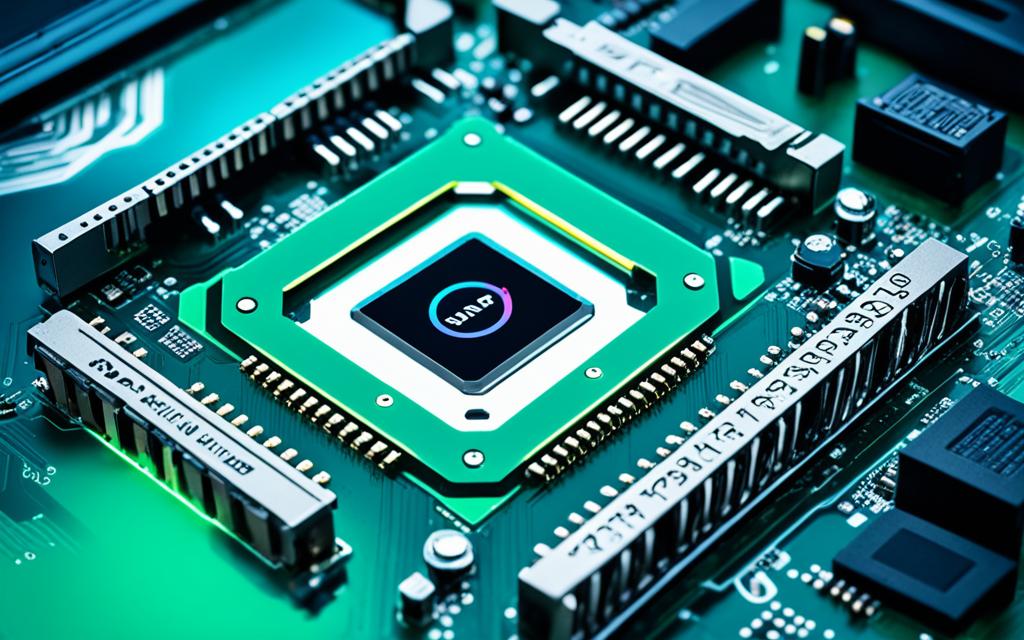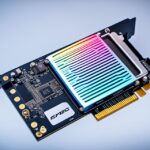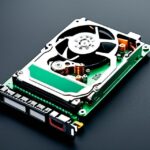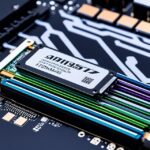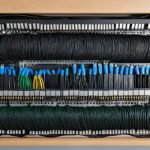Table of Contents
Solid-state drives, or SSDs, are quickly becoming more popular than old hard drives. They’re faster and perform better. But choosing the right SSD can be tricky. There are many types, like M.2, SATA, PCIe, and NVMe. Each has its own shape, size, and way of connecting to your computer.
For example, SATA 3 SSDs work at speeds of 600MB/s. Yet, the new PCIe Gen 5 SSDs can hit speeds up to 14,000MB/s. This shows why your motherboard must match your SSD to get the best speed1. Knowing the details of SSD and motherboard compatibility is key. It helps you upgrade without any problems. This way, you can improve your computer’s speed and enjoy a better experience.
Key Takeaways
- Understand different SSD types to ensure compatibility with your motherboard.
- SATA 3 runs at 6GB/s, while PCIe Gen 5 supports speeds up to 14,000MB/s.
- M.2 SSDs come in various sizes, including 22110, 2280, 2260, 2242, and 2230.
- 80% of recent motherboards feature more than one M.2 slot, enhancing upgrade options2.
- Check your motherboard’s specifications to confirm compatibility with M.2 SSDs.
Understanding SSD Types and Their Interfaces
Knowing the different SSD types and their interfaces boosts your computer’s performance. It lets users choose the right hardware wisely. SSDs mainly use SATA and PCIe interfaces, each offering unique benefits and features.
Different Interfaces Explained
SATA, launched in 2003, is widely used for SSDs. It reaches speeds up to 6Gb/s and can hold up to 1TB. This makes it perfect for average desktop use3. On the other hand, PCIe is better for tasks needing high performance. It uses NVMe protocol, allowing speeds up to 14,000MB/s4. PCIe offers efficiency, especially for quick storage needs.
The Importance of Compatibility
Matching SSDs with the right motherboards is crucial. A mismatch can cause SSDs not to work properly. SATA drives, for example, fit in 2.5″ or 3.5″ sizes. Laptops usually have 2.5″ drives, while desktops often use 3.5″ drives4.
mSATA drives suit small devices and come in full or half sizes4. M.2 SSDs, however, vary in size and need compatible motherboards. They require M or B key interfaces4. As technology advances, making devices that work together easily remains a key goal for manufacturers.
What are M.2, SATA, PCIe, and NVMe?
It’s key to know the different storage interfaces for better performance in today’s computers. The M.2 interface boosts this, allowing for SSDs that use SATA and the more powerful PCIe. Each type meets different needs of users.
M.2 Slot Variability
The M.2 slot is adaptable, fitting drives of many sizes like 30mm (2230), and up to 110mm (22110). With PCIe 2.0 lanes, it can reach speeds up to 2GB/s. This is over three times faster than SATA III’s 600MB/s limit5. Knowing your motherboard’s specs is vital to use M.2’s range properly.
Comparing SATA and PCIe Interfaces
SATA SSDs are known for being affordable and fit easily with most systems, but their speeds top out at about 6 Gbps. PCIe SSDs using NVMe, though, bring much quicker data speeds. They can hit speeds up to 7,500 MB/s, way beyond SATA SSDs6. This move to PCIe not only speeds things up but also allows handling many commands at once, unlike the older SCSI drives that can handle just one6.
Assessing Your Motherboard’s M.2 Slots
To check if your SSD will work, first find the M.2 slot on your motherboard. It’s usually close to the PCIe slots, about 22mm wide. The exact location can change with different motherboard models.
Locating the M.2 Slot on Your Motherboard
After spotting the M.2 area, look up your motherboard’s specs. This step is crucial because it tells you what SSDs it can handle. It tells you about size limits and if it supports special SSDs. M.2 drives are popular for being small and fast, often quicker than SATA drives. For more on M.2 differences, check here.
Identifying Slot Specifications
Check your motherboard’s details for SSD compatibility. Look for size and connection types. For example, PCIe 4.0 NVMe SSDs can move data up to 7,000 MB/s, much faster than SATA’s 600 MB/s78. M.2 drives are now common because they’re small and increase storage and speed. This makes them a great choice for any computer.
M.2 Connector Shapes and Their Implications
The M.2 connector shapes are key to SSD performance with different motherboards. There are two important key types in M.2: the B key and the M key. Knowing these helps fully use your SSD’s capacity.
Understanding B and M Keys
B key connectors match with SATA M.2 drives, using up to two lanes (PCIe x2). M key connectors, however, offer access to four lanes (PCIe x4) for higher performance. This distinction is crucial for SSD compatibility, affecting systems like the Asus G771 and Dell XPS 13, which require specific M and B key connections9. For example, the Samsung SM951 shines with M key due to its faster data transfer10.
How Keys Affect Compatibility
Knowing M.2 connector shapes avoids common SSD installation issues. Different connectors can cause compatibility problems, with certain rates of conflict for B and M keys11. It’s important to choose the right shape; dual M.2 slot systems offer more SSD options10. M.2 drives must also match motherboard specs in sizes like 2242 and 2280 for correct installation9.
| Connector Type | Supported Protocols | Maximum Lanes | Typical SSD Models |
|---|---|---|---|
| B Key | SATA, PCIe | Up to x2 | MyDigitalSSD SuperCache 2, Crucial M500 |
| M Key | PAT, NVMe | Up to x4 | Samsung SM951, Samsung XP941 |
| B & M Key | SATA, PCIe | Variable | Various dual-mode drives |
Understanding these connectors boosts SSD’s speed, its life, and reliability. It’s key when you’re upgrading.
Learn more about optimising your PC’s storage options
A Breakdown of M.2 SSD Sizes
M.2 SSDs come in sizes like 2230, 2242, 2260, 2280, and 22110. The first two digits, 22, show the width in millimetres. The last digits tell us the length. For example, a 2280 SSD is 80mm long. Larger SSDs usually have more storage space.
They can also have more NAND flash chips. This means better performance12. When buying an SSD, check if it fits in your computer’s M.2 slot.
Desktop computers often work with various SSD lengths. This is good for those wanting lots of storage. But, laptops might only fit certain sizes. Always check the space in your device before you buy. Look at your motherboard’s details to be sure of the right fit13.
Below is a comparative table of common M.2 SSD sizes and their respective uses:
| SSD Size | Length (mm) | Common Use Cases |
|---|---|---|
| 2230 | 30 | Compact devices, tablets |
| 2242 | 42 | Ultrabooks, portable SSDs |
| 2260 | 60 | Mid-range laptops |
| 2280 | 80 | Desktops, gaming systems |
| 22110 | 110 | High-capacity servers |
Knowing about M.2 SSD sizes helps make a smart choice. It affects how well your system works and how much it can store. As technology improves, it’s vital to pick the right SSD for your system.
How to Know if SSD is Compatible with Motherboard
To check if an SSD fits your motherboard, start by consulting the motherboard specifications. These details include supported M.2 interfaces, maximum lengths, and connector types. This step is key to selecting the right SSD, ensuring a smooth upgrade.
Consulting the Motherboard Specifications
First, look at your motherboard’s manual or product page. Here, you can find information about SSD support. Modern motherboards usually have several M.2 slots, adding flexibility for upgrades2. Make sure to see if your system works with PCIe or SATA SSDs and check for compatible M.2 sizes. M.2 slots can fit varies sized drives, like 2242, 2260, and 2280 mm1. Knowing these details helps avoid issues when installing the SSD.
Comparing SSD Dimensions with Slot Capacity
Then, it’s important to compare SSD dimensions with your motherboard’s slot capacity. Make sure the M.2 SSD length matches your motherboard’s slot size. Noticing the key types, like B-key and M-key, shows if the SSD will work with PCIe x2 or x4 operations1. The common lengths, such as 42mm for 2242 and 80mm for 2280, ensure the SSD fits well2. By following these steps, you can avoid compatibility problems and get better performance from your upgrade.
Considerations for 2.5-Inch SATA SSDs
Installing a 2.5-inch SATA SSD is generally easy, fitting well into many devices like laptops and desktops. It follows a standard size, making it perfect for most computer bays. Its simple integration is key for those looking to improve their system.
Installation Ease and Compatibility
Knowing your SSD’s size and specs is vital. The common SSD height choices, 7mm and 9.5mm, ensure a good fit in the bay. A 7mm SSD can go into a 9.5mm bay usually using brackets for stability. Not getting this right might block the install, highlighting precision’s value.
Choosing the Right Height for SSDs
The SSD height you pick must match your device’s specifications for smooth use and top performance. Manufacturers offer sizes and how-to guides, helping users pick the right one. Always double-check SSD and device guides to confirm height needs. Doing so makes sure the install runs smoothly, keeping your system running well141.
Conclusion
It’s crucial to match the SSD to your motherboard for the best performance. There are different SSD types like SATA, NVMe, and PCIe. Knowing about them helps you choose wisely for your upgrade15. Check the motherboard manual and seek experts’ guidance. This will help you keep your system running fast16.
NVMe SSDs are changing how we store data. They’re much faster than older drives, letting you do more at once17. Moving to SSDs from old hard drives makes your computer quicker and more efficient. This means faster loading and better data access for everyone.
Good advice and community tips help pick the right SSD for your needs and motherboard1517. Researching and understanding what works best makes upgrading easy. This leads to a big boost in how well your computer works and how happy you are with it.
FAQ
What types of SSDs are available on the market?
There are many SSDs available, including SATA, M.2, PCIe, and NVMe types. Each has different performance levels and motherboard compatibility.
How do I determine if my SSD is compatible with my motherboard?
Check your motherboard’s specs for compatible SSD interfaces and sizes. It’s essential for ensuring the SSD works well with your system.
What specifications should I check on my motherboard before purchasing an SSD?
Look at your motherboard for supported M.2 interfaces, SSD lengths, and connector types. This helps avoid buying an incompatible SSD.
What makes M.2 SSDs different from traditional SATA SSDs?
M.2 SSDs offer faster speeds and better data transfer than SATA SSDs. They support both NVMe and SATA protocols, with NVMe being quicker.
Can I use an M.2 SSD in both SATA and PCIe slots?
Using M.2 SSDs in SATA and PCIe slots depends on their connector keys and your motherboard’s M.2 slot capabilities. Always check compatibility first.
What are the different lengths for M.2 SSDs?
M.2 SSDs vary in lengths like 2230, 2242, 2260, 2280, and 22110. The number reveals their size, critical for fitting into your motherboard.
How important is the height of a 2.5-inch SATA SSD?
The height, either 7mm or 9.5mm, is important for 2.5-inch SATA SSDs to fit in your device. Mounting brackets may help with fitting issues.
What should I do if my SSD does not fit into the M.2 slot?
If your SSD won’t fit, check the key shape and length against the M.2 slot. Ensure it matches either SATA or PCIe needs.
Why is it crucial to understand the different SSD interfaces?
Knowing about SATA and PCIe interfaces helps choose the right upgrade. It avoids compatibility issues and improves your computer’s performance and efficiency.
Source Links
- https://www.xda-developers.com/m2-ssd-compatible-with-motherboard/ – How to know if an M.2 SSD is compatible with your motherboard
- https://www.kingspec.com/news/how-to-determine-the-compatibility-of-m2-pcie-ssd-with-the-motherboard.html – How To Determine The Compatibility Of M.2 PCIe SSD With The Motherboard
- https://www.10gtek.com/new-1415 – An Introduction to SSD Interface
- https://www.partitionwizard.com/clone-disk/ssd-compatibility.html – SSD Compatibility Check: How to Buy a Compatible SSD for PC – MiniTool Partition Wizard
- https://www.pugetsystems.com/labs/articles/overview-of-m-2-ssds-586/ – Overview of M.2 SSDs
- https://www.ibm.com/blog/nvme-vs-m2/ – NVMe vs. M.2: What’s the difference? – IBM Blog
- https://www.linkedin.com/pulse/how-choose-best-ssd-avoid-common-mistakes-blg-technologies-s211c – How to Choose the Best SSD and Avoid Common Mistakes
- https://www.tomshardware.com/reviews/ssd-buying-guide,5602.html – How to Buy the Right SSD: A Guide for 2024
- https://www.ramcity.com.au/blogs/news/m-2-ssd-guide-compatibility-list – M.2 SSD Guide / Compatibility List
- https://rog-forum.asus.com/t5/other-motherboards/m-2-ssd-compatibility-type-specifics-brand-with-maximus-vii/td-p/557043 – M.2 SSD compatibility type specifics/brand with Maximus VII Formula mobo?
- https://www.crucial.com/support/articles-faq-ssd/msata-m2-ssds-overview – mSATA and M.2 SSDs: What’s the difference?
- https://www.atpinc.com/blog/what-is-m.2-M-B-BM-key-socket-3 – What is M.2? Keys and Sockets Explained
- https://www.kingston.com/en/blog/pc-performance/two-types-m2-vs-ssd – 2 Types of M.2 SSDs: SATA and NVMe- Kingston Technology
- https://www.crucial.in/articles/about-ssd/ssd-form-factors – SSD Form Factors
- https://thetechsnews.com/how-to-check-if-ssd-is-compatible-with-motherboard/ – How To Check If Ssd Is Compatible With Motherboard
- https://www.crucial.com/articles/external-ssd/external-ssds-vs-internal-ssds – Internal vs External SSD: Which Type is Faster?
- https://www.electronicshub.org/does-my-motherboard-support-nvme/ – Does My Motherboard Support NVMe?

